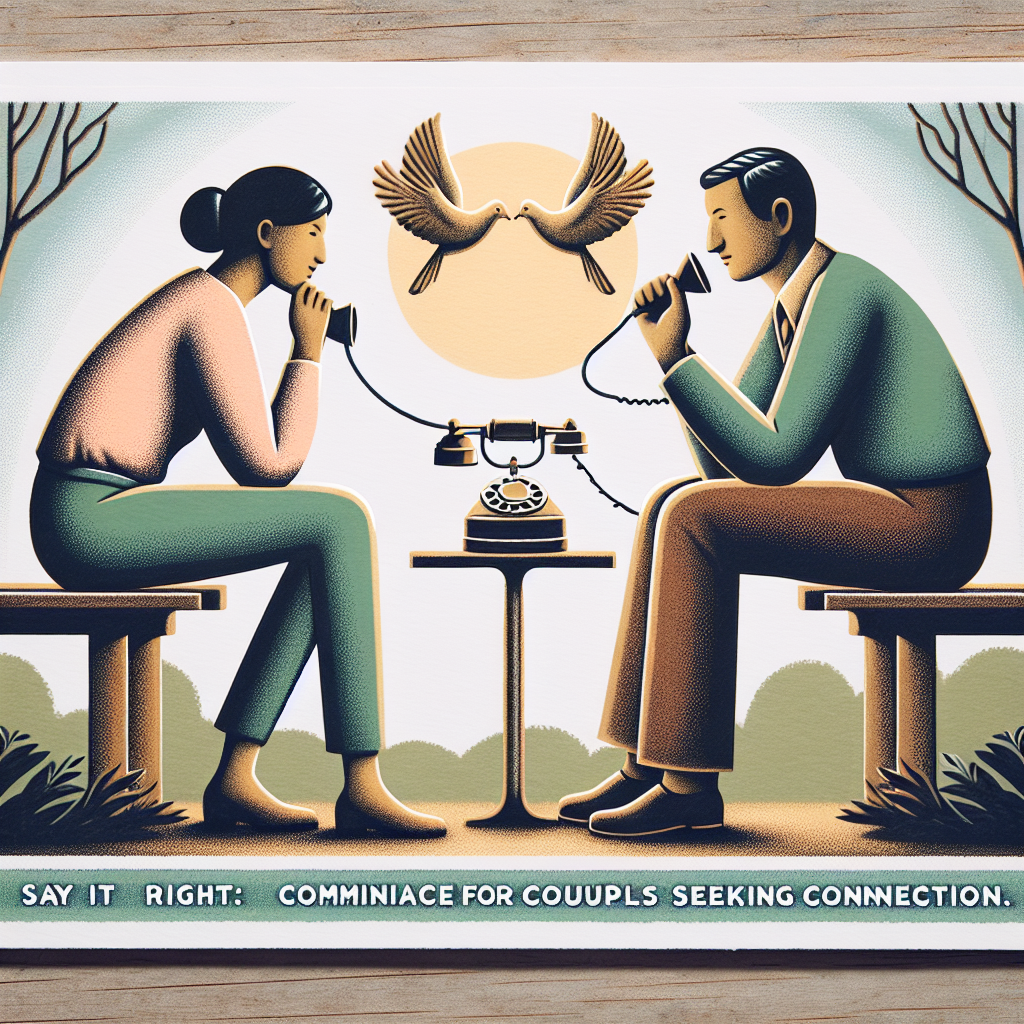
Say It Right: Communication Tools for Couples Seeking Connection for a Lasting Partnership
Introduction
In the vibrant tapestry of human relationships, the threads of communication can either weave an unbreakable bond or unravel the very fabric of intimacy. The saying "Say It Right" encapsulates the essence of effective communication, particularly for couples yearning to deepen their connection. In a world overflowing with distractions and individual pursuits, mastering the art of communication is essential to foster understanding, empathy, and a genuine connection. Say It Right: Communication Tools for Couples Seeking Connection will serve as your guide to navigate the complex landscape of relationship dynamics, empowering you to communicate efficiently and compassionately.
Effective communication can illuminate the path to resolving conflicts, enhancing intimacy, and nurturing love. Without it, misunderstandings festoon relationships, leading to feelings of isolation and disconnection. As we delve into the heart of this article, you’ll discover transformative tools that can elevate your relational dialogue from functional to profound. So, whether you’re embarking on a new relationship or have built a life together over several years, the following insights will provide you with the essential strategies to Say It Right.
The Foundations of Effective Communication
Understanding the Importance of Communication in Relationships
Communication isn’t just about exchanging words; it’s a nuanced dance of emotions, intentions, and understanding. In fact, experts assert that effective communication is the cornerstone of any successful relationship. According to a study published in the Journal of Marriage and Family, strong communication skills significantly correlate with relational satisfaction.
Case Study: The Thompson Couple
Take, for instance, the Thompson couple, who faced persistent communication challenges. Misinterpretations of simple phrases led to frequent arguments. After seeking marital counseling, they learned techniques to articulate their feelings effectively, transforming their discussions from contentious debates to constructive dialogues. This shift not only resolved their disputes but deepened their emotional intimacy.
Different Communication Styles
Recognizing that every individual has a unique communication style is critical for couples seeking to strengthen their relationship. Here are some common styles:
- Assertive Communication: This style involves expressing thoughts, feelings, and needs openly and respectfully.
- Aggressive Communication: This often involves dominating conversations, leading to conflict.
- Passive Communication: Individuals may avoid expressing their thoughts and feelings, often leading to resentment.
- Passive-Aggressive Communication: This style is characterized by indirect resistance and avoidance of direct confrontation.
Understanding your and your partner’s communication styles can help tailor your approach, making it easier to engage meaningfully.
Essential Communication Tools for Couples
Active Listening: The Heart of Connection
Active listening is one of the most potent tools couples can employ. This technique involves fully engaging with your partner, reflecting on what they say, and responding with empathy.
Key Elements of Active Listening
| Element | Description |
|---|---|
| Focus Attention | Eliminate distractions and give your partner your full attention. |
| Reflective Responses | Paraphrase what your partner said to clarify understanding. |
| Empathetic Engagement | Use nonverbal cues like nodding and eye contact to convey empathy. |
Actionable Insight: Try practicing active listening during your next conversation. Set aside distractions, maintain eye contact, and summarize what your partner shares to ensure clarity.
Nonverbal Communication: The Silent Language
Much of communication is nonverbal. Body language, facial expressions, and tone of voice can convey just as much meaning—if not more—than words.
Understanding Nonverbal Cues
- Posture: Open body language invites conversation, while closed posture can signal disinterest.
- Facial Expressions: A smile can encourage warmth and openness, while frowning may indicate discomfort or disagreement.
- Eye Contact: Steady eye contact fosters trust and connection but can feel confrontational if not balanced.
Case Study: The Martinez Family
The Martinez family struggled to understand each other due to high emotional stakes during discussions. By being conscious of their nonverbal signals, they learned to adjust their expressions and body language, dramatically improving their mutual understanding.
Setting Boundaries: Respecting Individual Needs
Boundaries are vital in any relationship; they help define respectful personal space and prevent misunderstandings. Openly discussing boundaries and expectations fosters a healthier communication climate.
Conflict Resolution: Navigating Arguments with Grace
Arguments are inevitable in relationships, but how they’re handled can significantly affect connection. Here are steps to navigate conflict wisely:
- Stay Calm: Take a moment to breathe and collect your thoughts before reacting.
- Use “I” Statements: Focus on your feelings to reduce defensiveness (e.g., “I feel hurt when…” instead of “You always…”).
- Seek Solutions Together: Approach the problem as a team rather than adversaries.
Case Study: The Lee Partnership
The Lee couple experienced frequent arguments that escalated quickly. By implementing conflict resolution techniques such as "I" statements, they were able to express their concerns without triggering defensiveness. This led to collaborative solutions rather than ongoing conflicts.
Expressing Appreciation: The Power of Positivity
Fostering a culture of appreciation strengthens bonds. Regularly expressing gratitude and acknowledging the positives in your partner can enhance emotional connections.
- Daily Affirmations: Share what you love about each other to cultivate positivity.
- Acts of Kindness: Small gestures of love can go a long way in demonstrating appreciation.
Data Insights: The Appreciation Effect
Research shows that couples who regularly express appreciation report higher levels of satisfaction. In a survey conducted with over 1,000 participants, 78% noted that expressing gratitude led to a more fulfilling relationship.
Utilizing Technology for Enhanced Connectivity
In a digital age, leveraging technology can augment communication. Here are some tools to consider:
- Couples Apps: Apps designed to improve communication and share schedules or goals foster connectivity.
- Video Chats: In long-distance relationships, visual communication can enhance emotional presence.
- Shared Journals: Writing or journaling together can refine communication and address unresolved issues.
Conclusion
In the quest for connection, couples armed with effective communication tools will find themselves navigating the complexities of relationships with grace. By prioritizing active listening, establishing boundaries, respecting individual styles, and fostering a culture of appreciation, couples can cultivate a deeper sense of intimacy and understanding.
Remember, the journey to effective communication requires practice and patience. Embrace each opportunity to Say It Right: Communication Tools for Couples Seeking Connection and watch as your relationship flourishes into a profound partnership.
FAQs
1. What are some quick tips for improving communication in a relationship?
Focus on active listening, express appreciation frequently, and practice using "I" statements to express feelings without assigning blame.
2. How can I encourage my partner to communicate better?
Set aside quality time to talk, share your own communication goals, and provide positive reinforcement when they practice effective communication.
3. What should I do if communication breaks down completely?
Consider seeking help from a couples therapist or counselor who can guide you through the process of effective communication and conflict resolution.
4. How can technology aid in improving relationship communication?
Technology can offer tools like communication apps, shared calendars, and video calls to facilitate understanding and keep couples connected despite distance or busy schedules.
5. Why is nonverbal communication important in relationships?
Nonverbal communication conveys emotions and intentions that words might not. Being aware of body language, tone, and facial expressions helps partners better understand each other.
By integrating these insights and tools into your daily interactions, you ensure that the essence of your partnership remains vibrant and strong. Embrace the journey—communicate effectively, and the connection you seek will blossom.
















